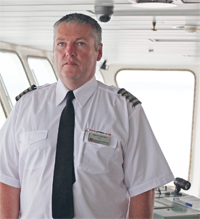Captain Colin Bain, master of Caledonian Isles on the busy Ardrossan-Brodick route, talked to Nicholas Leach about his career and working for Cal Mac.
When did you start your career at sea? Just after my 17th birthday I went to sea. When I was 16 and still at school, I went to the careers evening, and saw the British Council of British Shipping, and before I knew it I was at their office at Broomielaw in Glasgow being interviewed for a position with Shell tankers. I was accepted by Shell and did my induction with them in July 1981. I was a cadet with Shell for four years, during which time I passed my tickets and became third mate on product tankers, VLCCs, ULCCs and large 318,000-ton crude oil tankers, travelling round the world. We loaded in the Gulf, then went to northern Europe ports such as Rotterdam. The Shell tankers included Litiopia, which was of 314,000 tons and carried crude oil, and Entalina a 30,000-ton product carrier. I also had a spell working on LNG carriers.
What other companies have you worked for?After tankers, I went to Maersk to work on anchor handlers in the North Sea out of Aberdeen. I worked on Maersk Riderand Maersk Ranger, on rotas of five weeks on, five weeks off. We were in and out of Aberdeen doing supply work as well as anchor handling. The shifts varied and we would go wherever there was work. I worked with Maersk for just three years, serving as Second Mate. Then, as my wife is from Dublin, we moved over here, and ended up living in Gourock.
Did you want to work in the ferry industry?When I was in Gourock I just phoned CalMac on the off chance that they might have some work, was offered four weeks starting in May 1991, and I have been here ever since. I worked on Isle of Arran as Second Mate on the Arran route, and was initially only on a temporary contract, so I used to do relief work around the fleet, going up north to work the various routes there. I was assigned to the Clyde fleet, and was Second Mate on Caledonian Isles from 1993 when she was new. I served on most of the ships in the CalMac fleet when I was relief Chief Officer.

How long have you worked on this ship?I started on this ship from 1993, and came here with a Class 3 ticket. CalMac let me train for my Chief Mate’s certificate and my Master’s ticket, which I acquired in 1999. I was then Relief Mate around the fleet for a while and then promoted to Master. My first ship as Master was Isle of Arran. Working for CalMac is good, as it enables me to be at sea while I also have a good home life.
What are the crewing arrangements? The first sailing is 0700 from Ardrossan, and we do five round trips a day, six on a Friday. There are 35 crew in the summer, down to 29 in the winter, and in the summer we can often carry almost 1,000 passengers. We are quite heavily affected by the weather, as good weather makes for much busier crossings. The car traffic does not vary too much, but the number of foot passengers can increase considerably during good weather in the summer.
What shifts do you and the crew work?Because of the hours of rest regulations, we work two weeks on and two weeks off, with staggered rest breaks to comply with the regulations. So a Mate could start work at 0600 and have a two-hour rest break during the day. The crew come mainly from local areas, but recently they are coming from further afield, although we still have many crew from Scotland. Our Second Engineer comes from Dublin and many come from England, although a high proportion of the crew still come from the Western Isles, including Barra, Lewis and Tiree. We have two Latvian stewardesses, but they are both UK residents.
What is the most useful innovation you have seen on ships in your time on board?Probably GPS combined with the electronic charts and the integration of radar and radio systems, which gives us our immediate position, so if we ever sent out a distress call they would know exactly wherewewere.


